History of CARL
In 2003 we started at the Universitaet Tuebingen an experiment to study the behavior of atoms in a high-finesse ring cavity.
In such a ring cavity light can travel in two counter-propagating directions, which gives rise to a standing light wave in which atoms
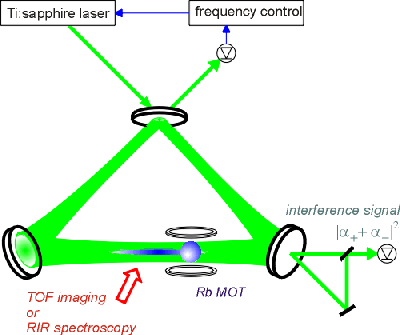 can be trapped. However, in a ring cavity the phase of the standing wave is free to rotate. For very high finesses, the cavity field
can be trapped. However, in a ring cavity the phase of the standing wave is free to rotate. For very high finesses, the cavity field
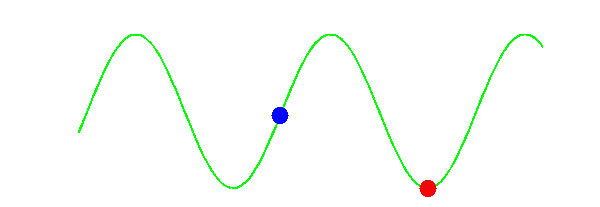 decouples from the lasers and becoms extremely sensitive to other coupling mechanisms. For instance, the light scattered from a single
atom between the counter-propagating modes can substantially shift the phase. Thus the scattering of light not only kicks the atom, but
has also a backaction on the standing wave, in the sense of a phase-shift.
decouples from the lasers and becoms extremely sensitive to other coupling mechanisms. For instance, the light scattered from a single
atom between the counter-propagating modes can substantially shift the phase. Thus the scattering of light not only kicks the atom, but
has also a backaction on the standing wave, in the sense of a phase-shift.
The shift of the optical lattice induced by scattering off an atom is obviously sensed by all the other atoms. Their motion
gets thus correlated. This means that kinetic energy can be exchanged between atoms, even if they are located at distant lattice
sites.
CARL detected
Our ring cavity consists of two high-reflecting curved mirrors and an input coupler. The transmissions of the mirrors
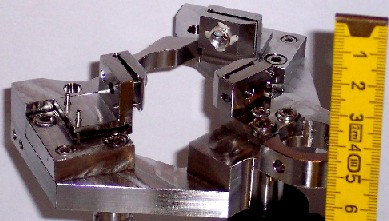 depend on the (linear) polarization of the light modes and are for s-polarization on the order of a few ppm. We measure
using the ring-down method a finesse of F = 135000 corresponding to a cavity linewidth of 13 kHz. The round-trip length
of the ring-cavity is 8.7 cm, the beam waist at the location of the MOT is about 100 mm.
The intracavity power, largely enhanced by the factor F to values around 10 W, gives rise to a deep optical potential
at detunings on th order of 1 nm. The ring cavity is driven in one or two directions by a titanium-sapphire laser. The Ti:sapphire
laser is locked to one of the eigenfrequencies of the ring cavity using the Pound-Drever-Hall locking technique.
depend on the (linear) polarization of the light modes and are for s-polarization on the order of a few ppm. We measure
using the ring-down method a finesse of F = 135000 corresponding to a cavity linewidth of 13 kHz. The round-trip length
of the ring-cavity is 8.7 cm, the beam waist at the location of the MOT is about 100 mm.
The intracavity power, largely enhanced by the factor F to values around 10 W, gives rise to a deep optical potential
at detunings on th order of 1 nm. The ring cavity is driven in one or two directions by a titanium-sapphire laser. The Ti:sapphire
laser is locked to one of the eigenfrequencies of the ring cavity using the Pound-Drever-Hall locking technique.
The backaction of atoms on the light stored in a high-Q ring-cavity can have various signatures.
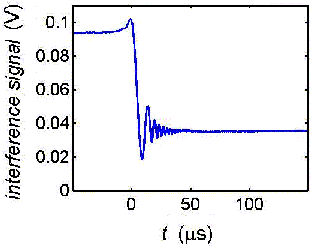 One of them is the observation that moving atoms shift the phase of the standing wave by scattering photons between the modes.
The scattering can be strong enough to generate a standing wave out of a travelling one. In march 2003 been have able
to verify this feature by the following experiment. We loaded about 106 atoms from the magneto-optical trap into our
ring-cavity standing wave. If the atoms sit near the antinodes, the photon scattering from one mode into the other is balanced.
After 50 ms we switched off one of the counter-propagating modes. The atoms responded to the sudden intensity imbalance of
the modes by scattering photons from the full into the empty mode. The recoil transferred by the scattering process accelerated
One of them is the observation that moving atoms shift the phase of the standing wave by scattering photons between the modes.
The scattering can be strong enough to generate a standing wave out of a travelling one. In march 2003 been have able
to verify this feature by the following experiment. We loaded about 106 atoms from the magneto-optical trap into our
ring-cavity standing wave. If the atoms sit near the antinodes, the photon scattering from one mode into the other is balanced.
After 50 ms we switched off one of the counter-propagating modes. The atoms responded to the sudden intensity imbalance of
the modes by scattering photons from the full into the empty mode. The recoil transferred by the scattering process accelerated
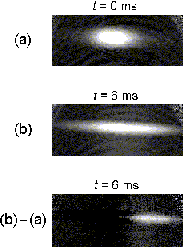 the atoms. This in turn drags the cavity-standing wave. We observed the phase evolution of the standing wave by beating two
output beams corresponding to the two counter-propagating modes on a photodiode. We see that the phase of the cavity field is,
indeed, dragged by the atoms. The observations are in good qualitative agreement with simulated curves based on a theory by Gangl
et al. [Phys. Rev. A 61, 043405 (2000)]. The observations constitute the
first unambiguous realization of a correlated atomic recoil laser
(CARL) predicted by Bonifacio and coworkers in 1994
[R. Bonifacio and L. de Salvo, Nucl. Instr. Meth. Phys. Res. A 341, 360 (1994)].
the atoms. This in turn drags the cavity-standing wave. We observed the phase evolution of the standing wave by beating two
output beams corresponding to the two counter-propagating modes on a photodiode. We see that the phase of the cavity field is,
indeed, dragged by the atoms. The observations are in good qualitative agreement with simulated curves based on a theory by Gangl
et al. [Phys. Rev. A 61, 043405 (2000)]. The observations constitute the
first unambiguous realization of a correlated atomic recoil laser
(CARL) predicted by Bonifacio and coworkers in 1994
[R. Bonifacio and L. de Salvo, Nucl. Instr. Meth. Phys. Res. A 341, 360 (1994)].
The beat signal oscillations essentially reveal the dynamics of the standing wave. But it is also interesting to probe the
dynamics of the atoms, i.e. their position and their velocity. The atomic density distribution can be monitored by absorption
imaging, the velocity distribution by spectroscopy of recoil-induced resonances. The figure shows the displacement of the
center-of-mass of the atomic cloud after 6 ms CARL dynamics. The displacement coincides
with the displacement of the standing wave.
First BEC in a cavity
To study CARL in the regime of quantized motion we have set up an experiment, where atoms are Bose-Einstein condensed (BEC) before
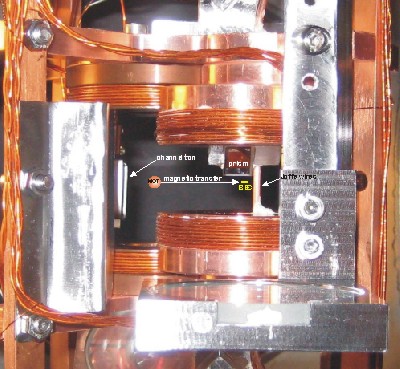 being transferred into an optical cavity. In october 2006 we were observed collective dynamics of BECs interacting with the two
counterpropagating modes of the cavity. This has been the first experiment worldwide with BECs in a cavity. The high finesse of
the cavity permitted us reach the strong collective coupling regime.
being transferred into an optical cavity. In october 2006 we were observed collective dynamics of BECs interacting with the two
counterpropagating modes of the cavity. This has been the first experiment worldwide with BECs in a cavity. The high finesse of
the cavity permitted us reach the strong collective coupling regime.
We observed collective atomic recoil lasing (CARL) and superradiant Rayleigh scattering with ultracold and Bose-Einstein condensed
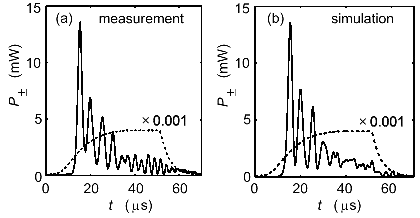 atoms in an optical ring cavity. Both phenomena are based on instabilities evoked by the collective interaction of light with cold
atomic gases. Our observation clarifies the link between the two effects. The observation of superradiant behavior with thermal clouds
as hot as several tens of uK proves that the phenomena are driven by the cooperative dynamics of the atoms, which is strongly enhanced
by the presence of the ring cavity.
atoms in an optical ring cavity. Both phenomena are based on instabilities evoked by the collective interaction of light with cold
atomic gases. Our observation clarifies the link between the two effects. The observation of superradiant behavior with thermal clouds
as hot as several tens of uK proves that the phenomena are driven by the cooperative dynamics of the atoms, which is strongly enhanced
by the presence of the ring cavity.
Children's corner
Here you can watch the behaviour of a cavity-field coupled to an atom. The cavity is symmetrically pumped. The red dots
denote the standing wave light field and the blue dot is the atom.
Watch an atom released in a cavity standing wave.
Watch an atom pinned at a fixed position in a cavity standing wave.
Watch an atom in a cavity standing wave whose one direction is suddenly switched off.
Evaluate our ring cavity parameters.
Two atoms in a cavity standing wave start to move collectively.
Page updated 23.11.2015
 can be trapped. However, in a ring cavity the phase of the standing wave is free to rotate. For very high finesses, the cavity field
can be trapped. However, in a ring cavity the phase of the standing wave is free to rotate. For very high finesses, the cavity field
 decouples from the lasers and becoms extremely sensitive to other coupling mechanisms. For instance, the light scattered from a single
atom between the counter-propagating modes can substantially shift the phase. Thus the scattering of light not only kicks the atom, but
has also a backaction on the standing wave, in the sense of a phase-shift.
decouples from the lasers and becoms extremely sensitive to other coupling mechanisms. For instance, the light scattered from a single
atom between the counter-propagating modes can substantially shift the phase. Thus the scattering of light not only kicks the atom, but
has also a backaction on the standing wave, in the sense of a phase-shift. depend on the (linear) polarization of the light modes and are for s-polarization on the order of a few ppm. We measure
using the ring-down method a finesse of F = 135000 corresponding to a cavity linewidth of 13 kHz. The round-trip length
of the ring-cavity is 8.7 cm, the beam waist at the location of the MOT is about 100
depend on the (linear) polarization of the light modes and are for s-polarization on the order of a few ppm. We measure
using the ring-down method a finesse of F = 135000 corresponding to a cavity linewidth of 13 kHz. The round-trip length
of the ring-cavity is 8.7 cm, the beam waist at the location of the MOT is about 100  One of them is the observation that moving atoms shift the phase of the standing wave by scattering photons between the modes.
The scattering can be strong enough to generate a standing wave out of a travelling one. In march 2003 been have able
to verify this feature by the following experiment. We loaded about 106 atoms from the magneto-optical trap into our
ring-cavity standing wave. If the atoms sit near the antinodes, the photon scattering from one mode into the other is balanced.
After 50 ms we switched off one of the counter-propagating modes. The atoms responded to the sudden intensity imbalance of
the modes by scattering photons from the full into the empty mode. The recoil transferred by the scattering process accelerated
One of them is the observation that moving atoms shift the phase of the standing wave by scattering photons between the modes.
The scattering can be strong enough to generate a standing wave out of a travelling one. In march 2003 been have able
to verify this feature by the following experiment. We loaded about 106 atoms from the magneto-optical trap into our
ring-cavity standing wave. If the atoms sit near the antinodes, the photon scattering from one mode into the other is balanced.
After 50 ms we switched off one of the counter-propagating modes. The atoms responded to the sudden intensity imbalance of
the modes by scattering photons from the full into the empty mode. The recoil transferred by the scattering process accelerated
 the atoms. This in turn drags the cavity-standing wave. We observed the phase evolution of the standing wave by beating two
output beams corresponding to the two counter-propagating modes on a photodiode. We see that the phase of the cavity field is,
indeed, dragged by the atoms. The observations are in good qualitative agreement with simulated curves based on a theory by Gangl
et al. [Phys. Rev. A 61, 043405 (2000)]. The observations constitute the
first unambiguous realization of a correlated atomic recoil laser
(CARL) predicted by Bonifacio and coworkers in 1994
[R. Bonifacio and L. de Salvo, Nucl. Instr. Meth. Phys. Res. A 341, 360 (1994)].
the atoms. This in turn drags the cavity-standing wave. We observed the phase evolution of the standing wave by beating two
output beams corresponding to the two counter-propagating modes on a photodiode. We see that the phase of the cavity field is,
indeed, dragged by the atoms. The observations are in good qualitative agreement with simulated curves based on a theory by Gangl
et al. [Phys. Rev. A 61, 043405 (2000)]. The observations constitute the
first unambiguous realization of a correlated atomic recoil laser
(CARL) predicted by Bonifacio and coworkers in 1994
[R. Bonifacio and L. de Salvo, Nucl. Instr. Meth. Phys. Res. A 341, 360 (1994)]. being transferred into an optical cavity. In october 2006 we were observed collective dynamics of BECs interacting with the two
counterpropagating modes of the cavity. This has been the first experiment worldwide with BECs in a cavity. The high finesse of
the cavity permitted us reach the strong collective coupling regime.
being transferred into an optical cavity. In october 2006 we were observed collective dynamics of BECs interacting with the two
counterpropagating modes of the cavity. This has been the first experiment worldwide with BECs in a cavity. The high finesse of
the cavity permitted us reach the strong collective coupling regime. atoms in an optical ring cavity. Both phenomena are based on instabilities evoked by the collective interaction of light with cold
atomic gases. Our observation clarifies the link between the two effects. The observation of superradiant behavior with thermal clouds
as hot as several tens of uK proves that the phenomena are driven by the cooperative dynamics of the atoms, which is strongly enhanced
by the presence of the ring cavity.
atoms in an optical ring cavity. Both phenomena are based on instabilities evoked by the collective interaction of light with cold
atomic gases. Our observation clarifies the link between the two effects. The observation of superradiant behavior with thermal clouds
as hot as several tens of uK proves that the phenomena are driven by the cooperative dynamics of the atoms, which is strongly enhanced
by the presence of the ring cavity.